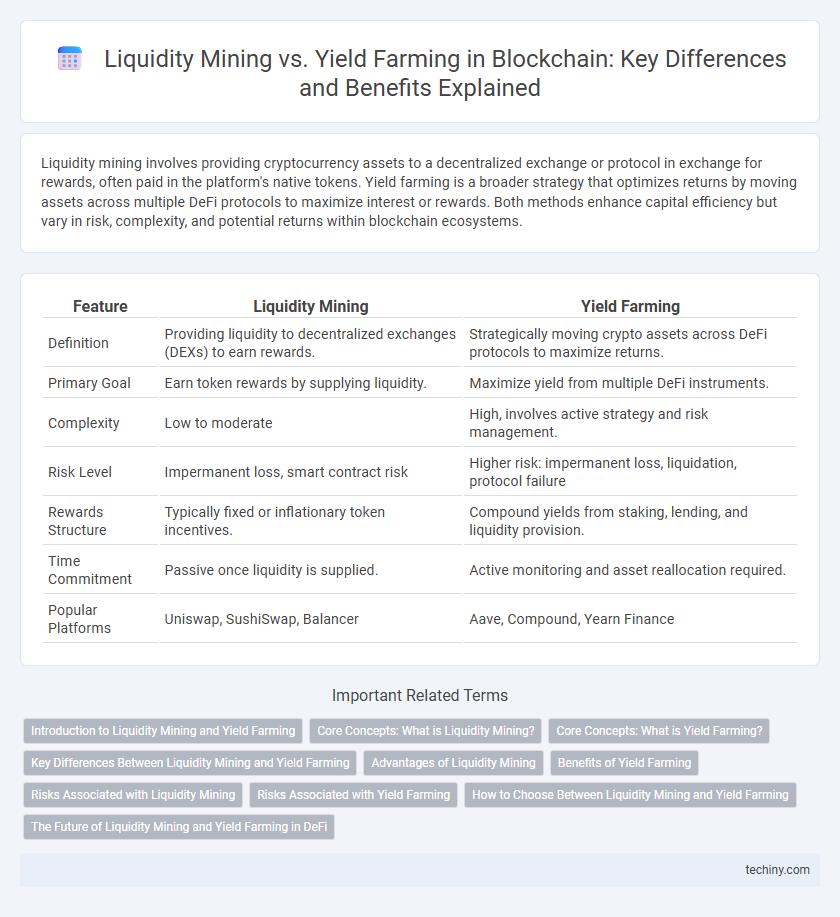Liquidity mining involves providing cryptocurrency assets to a decentralized exchange or protocol in exchange for rewards, often paid in the platform's native tokens. Yield farming is a broader strategy that optimizes returns by moving assets across multiple DeFi protocols to maximize interest or rewards. Both methods enhance capital efficiency but vary in risk, complexity, and potential returns within blockchain ecosystems.
Table of Comparison
| Feature | Liquidity Mining | Yield Farming |
|---|---|---|
| Definition | Providing liquidity to decentralized exchanges (DEXs) to earn rewards. | Strategically moving crypto assets across DeFi protocols to maximize returns. |
| Primary Goal | Earn token rewards by supplying liquidity. | Maximize yield from multiple DeFi instruments. |
| Complexity | Low to moderate | High, involves active strategy and risk management. |
| Risk Level | Impermanent loss, smart contract risk | Higher risk: impermanent loss, liquidation, protocol failure |
| Rewards Structure | Typically fixed or inflationary token incentives. | Compound yields from staking, lending, and liquidity provision. |
| Time Commitment | Passive once liquidity is supplied. | Active monitoring and asset reallocation required. |
| Popular Platforms | Uniswap, SushiSwap, Balancer | Aave, Compound, Yearn Finance |
Introduction to Liquidity Mining and Yield Farming
Liquidity mining involves users providing cryptocurrency assets to decentralized finance (DeFi) protocols in exchange for rewards, often in the form of native tokens, incentivizing liquidity for trading pairs. Yield farming expands on this concept by strategically moving assets across multiple DeFi platforms to maximize returns through interest, rewards, and token appreciation. Both practices play a crucial role in enhancing DeFi ecosystem efficiency by increasing capital availability and incentivizing user participation.
Core Concepts: What is Liquidity Mining?
Liquidity mining involves users providing cryptocurrency assets to decentralized finance (DeFi) protocols' liquidity pools in exchange for rewards, often paid in the platform's native tokens. This process enhances market liquidity by enabling seamless token swaps and lending activities while incentivizing participation through yield generation. Unlike traditional yield farming, liquidity mining specifically emphasizes contributing to liquidity pools to sustain decentralized exchange operations.
Core Concepts: What is Yield Farming?
Yield farming is a decentralized finance (DeFi) strategy where users lock or lend their cryptocurrency assets in smart contracts to earn rewards, often in the form of additional tokens. It involves providing liquidity to DeFi protocols, which enables the platform's functions such as lending, borrowing, or trading, while generating passive income. Yield farming typically includes multiple layers of rewards, such as transaction fees and governance tokens, maximizing returns for liquidity providers.
Key Differences Between Liquidity Mining and Yield Farming
Liquidity mining primarily involves providing assets to a decentralized exchange's liquidity pool to earn transaction fees and native tokens, whereas yield farming encompasses a broader range of strategies focused on maximizing returns by leveraging various DeFi protocols. Liquidity mining rewards participants directly for increasing liquidity, often with governance tokens, while yield farming requires active strategy shifts, including staking, lending, and harvesting multiple token rewards. Understanding these distinctions is crucial for optimizing investment returns and managing risks in decentralized finance ecosystems.
Advantages of Liquidity Mining
Liquidity mining offers users the advantage of earning native tokens as rewards, enhancing potential returns beyond standard transaction fees. By providing liquidity to decentralized exchanges, participants contribute to market efficiency and benefit from passive income streams with relatively lower risk compared to some yield farming strategies. This method also supports network security and growth by incentivizing continuous liquidity provision.
Benefits of Yield Farming
Yield farming offers enhanced capital efficiency by allowing users to earn multiple types of rewards simultaneously, maximizing returns on crypto assets. It provides flexibility through diverse strategies and protocols, enabling participants to optimize yields based on risk tolerance and market conditions. The potential for higher annual percentage yields (APYs) compared to liquidity mining attracts investors seeking to compound earnings in decentralized finance (DeFi) ecosystems.
Risks Associated with Liquidity Mining
Liquidity mining involves locking tokens in decentralized exchanges to earn rewards but exposes participants to impermanent loss, smart contract vulnerabilities, and market volatility. Yield farming, while similar, often includes a broader range of strategies and higher risk due to complex protocols and reward mechanisms. Understanding these risks is crucial for maximizing returns and protecting investments in decentralized finance (DeFi).
Risks Associated with Yield Farming
Yield farming involves higher risks than liquidity mining due to exposure to smart contract vulnerabilities, impermanent loss, and volatile token prices. The complexity of multiple protocol interactions in yield farming increases the likelihood of exploits, while fluctuating rewards can lead to unpredictable returns. Investors must carefully assess the security of the underlying platforms and market conditions to mitigate potential losses.
How to Choose Between Liquidity Mining and Yield Farming
Choosing between liquidity mining and yield farming depends on risk tolerance, investment goals, and platform incentives; liquidity mining typically offers more stable returns with lower risk by providing assets to decentralized exchanges, while yield farming involves leveraging and staking multiple tokens for potentially higher but more volatile rewards. Assess factors such as impermanent loss exposure, token lock-up periods, and reward structures to align strategy with financial objectives. Evaluating platform security and historical performance helps mitigate risks in both liquidity mining and yield farming.
The Future of Liquidity Mining and Yield Farming in DeFi
Liquidity mining and yield farming are set to evolve with enhanced protocols integrating automated market makers (AMMs) and cross-chain interoperability, driving deeper liquidity and higher capital efficiency in DeFi ecosystems. Emerging solutions leveraging layer-2 scaling and smart contract composability will reduce transaction costs and mitigate impermanent loss, attracting more participants and institutional investors. The future of these mechanisms hinges on innovative tokenomics and governance models that foster sustainable incentives and robust security frameworks in decentralized finance.
Liquidity Mining vs Yield Farming Infographic

 techiny.com
techiny.com